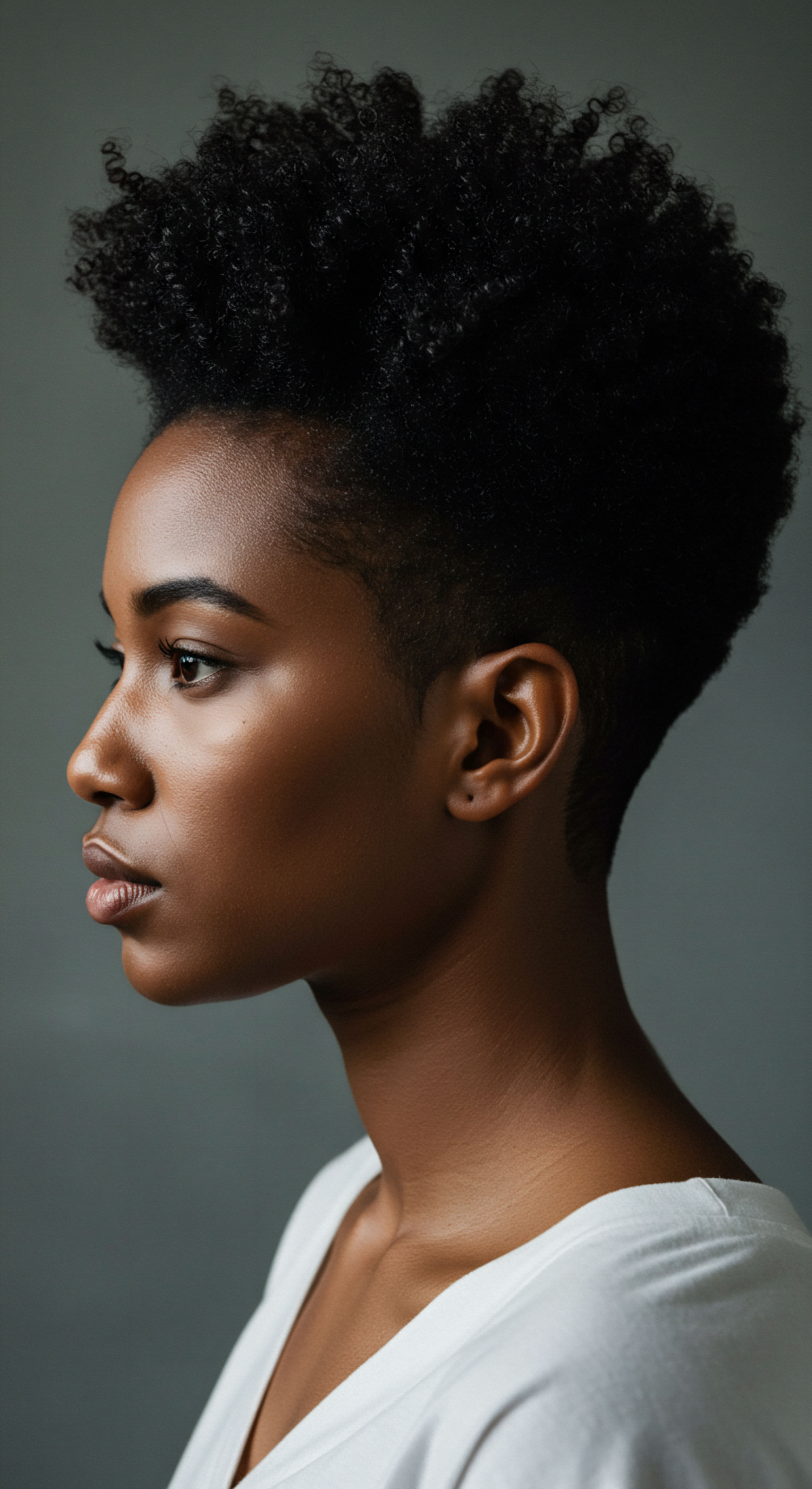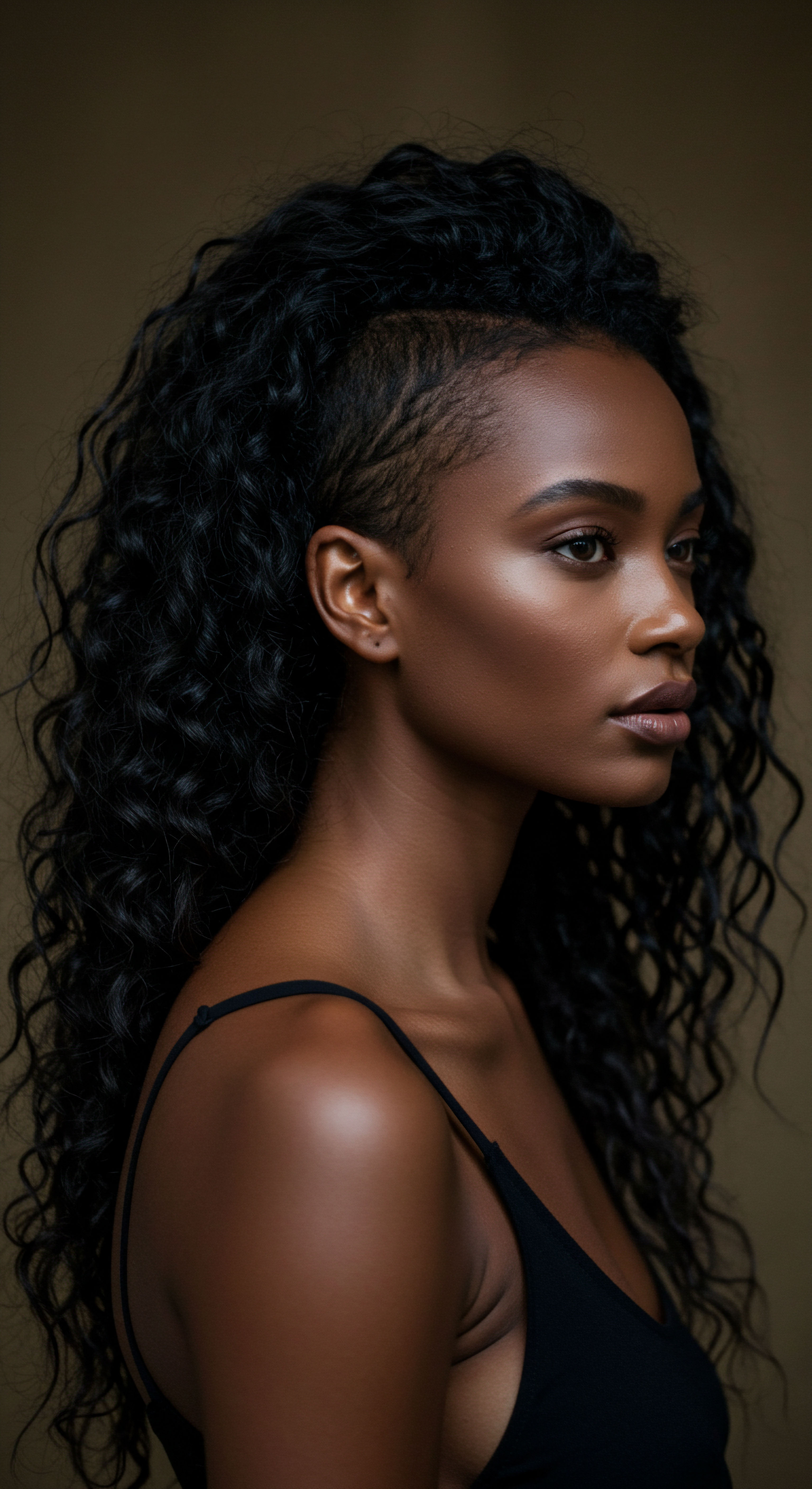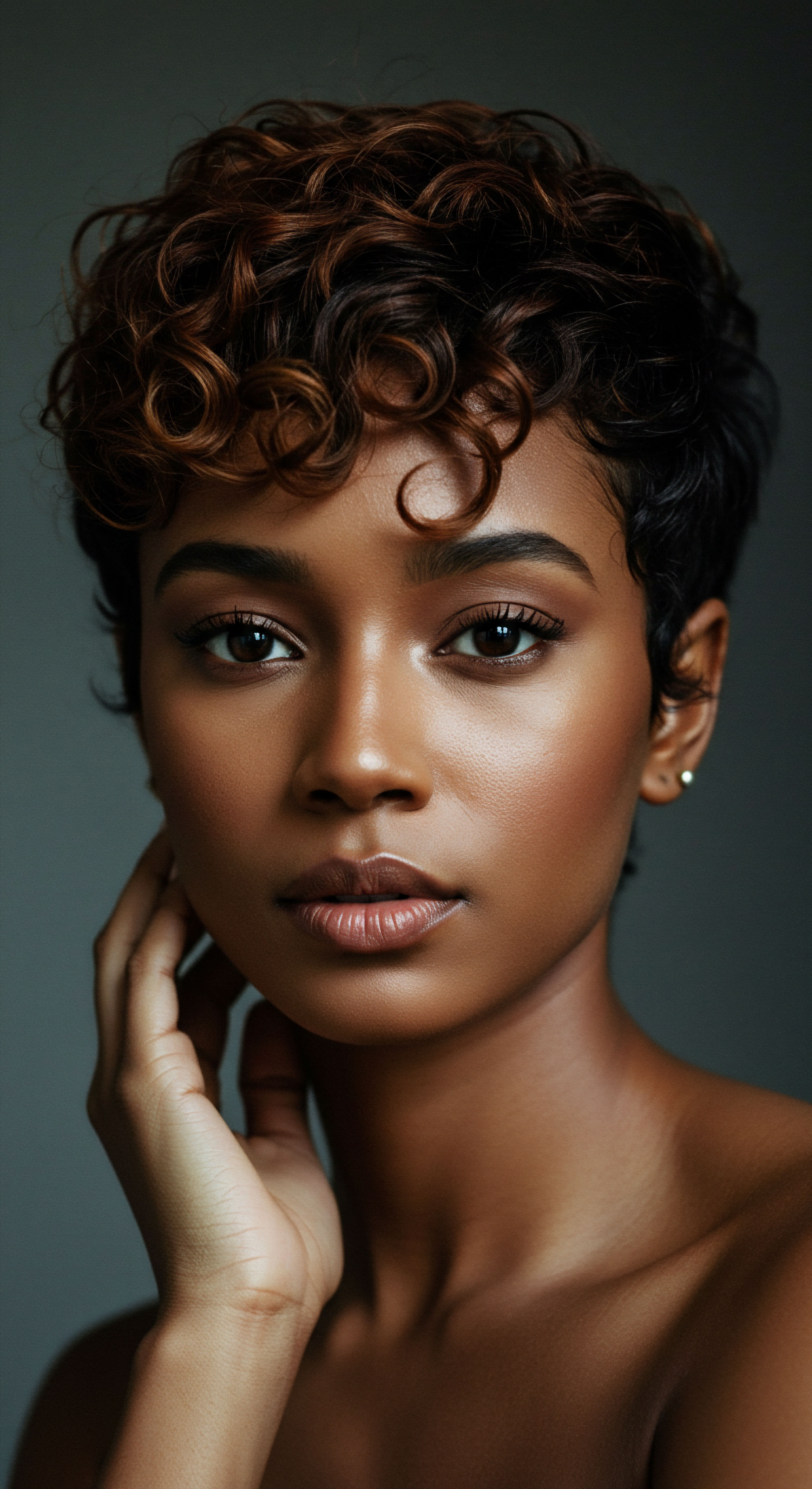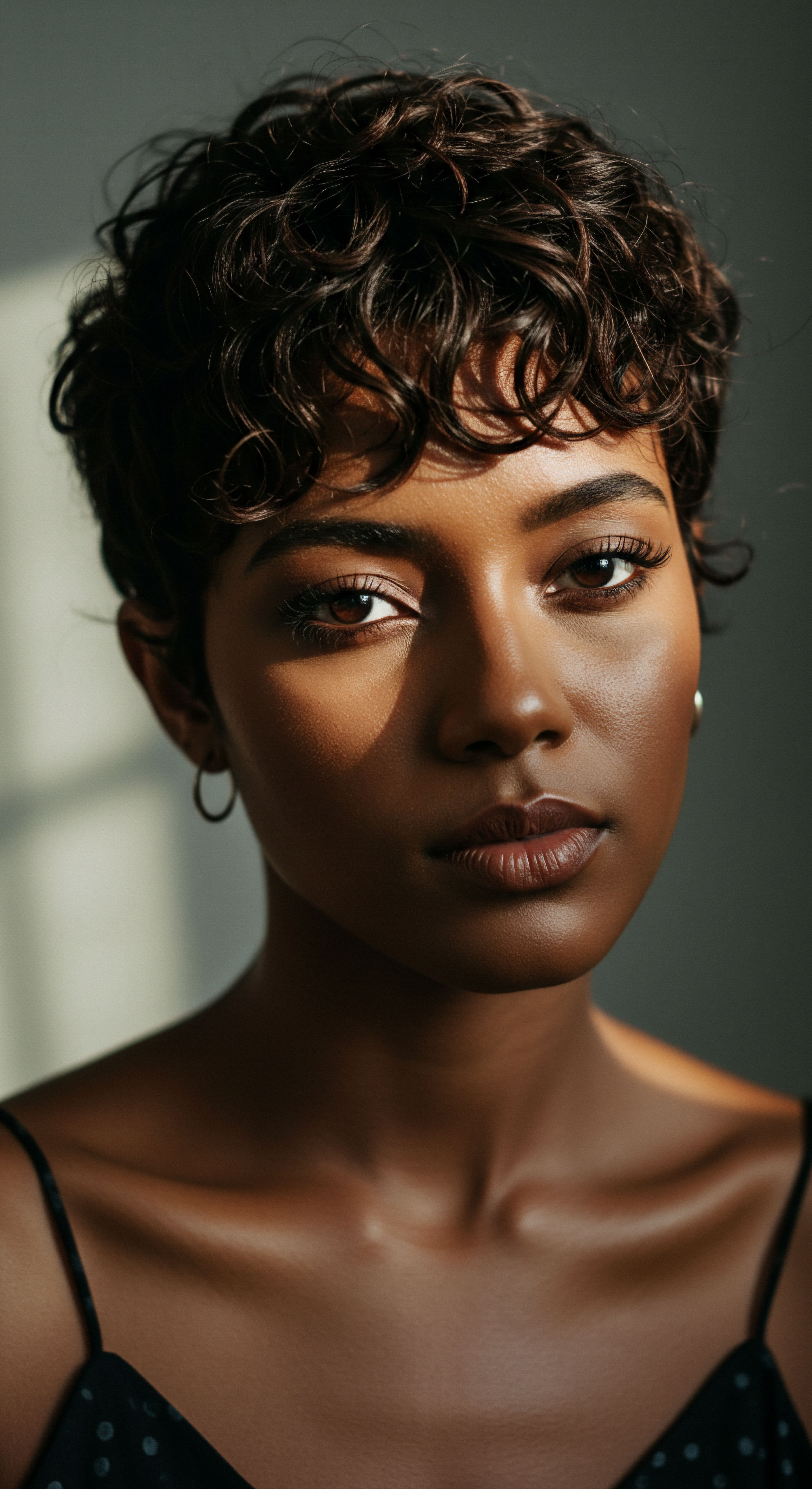
Roots
Consider the quiet rustle of fabric, a whisper against the scalp, a gesture performed with mindful hands. This simple act, repeated across countless generations and continents, holds within its folds stories as old as time itself. Hair wrapping, far from being a mere adornment or a fleeting trend, stands as a profound testament to human ingenuity, cultural continuity, and personal agency.
It is a practice deeply etched into the collective memory of humanity, particularly within communities whose histories have often been obscured or misrepresented. Uncovering its origins reveals not just a fashion statement, but a complex interplay of practicality, spirituality, and social discourse.
From the earliest known records, dating back to civilizations of antiquity, the act of covering one’s hair carried weight. Ancient Assyrian texts from the 13th century BCE, for instance, describe head coverings as a marker of social standing, reserved for aristocratic women and forbidden for those of lower status. This early distinction established a pattern, where the visible act of veiling or wrapping communicated a wearer’s place within a societal structure.
The threads used, the colors chosen, and the manner of wrapping often conveyed silent messages about wealth, marital status, or even religious devotion. These early forms set a precedent, laying the groundwork for the diverse meanings hair wrapping would acquire over millennia.

Ancient Echoes of Covered Crowns
Across diverse ancient cultures, hair covering appeared in various forms, each imbued with its own specific significance. In ancient Egypt, for example, evidence suggests that pharaohs wore headbands or covered their hair with wigs, sometimes crowned with cloth-based divine crowns that carried distinct meanings. This practice extended beyond royalty; women from Nubia also adopted headwraps, signaling a widespread recognition of hair’s symbolic potential. The presence of such coverings in funerary art and historical accounts points to their established role in daily life and ceremonial contexts.
Hair wrapping is a practice deeply rooted in human history, reflecting societal structures, spiritual beliefs, and personal identity across many ancient civilizations.
In the Greco-Roman world, while hair was often displayed as a feature of beauty, certain forms of head coverings existed. Greek maidens might reveal their long hair, yet married women sometimes wore a kalyptra (a small shawl) or a sakkos (a snood). These were not always strictly about modesty; at times, they were ornamental, a part of one’s attire.
Yet, even in these instances, the presence of a covering contributed to a visual language, distinguishing individuals within their social spheres. The interplay between revealing and concealing hair spoke volumes about an individual’s role, status, and adherence to cultural norms.

Sub-Saharan Africa and the Beginnings of Textured Hair Expression
The origins of hair wrapping, particularly as it relates to textured hair, trace back with remarkable clarity to Sub-Saharan Africa. Here, centuries before the transatlantic slave trade, headwraps were not merely practical; they were vibrant expressions of culture, status, and spirituality. Different regions and ethnic groups developed their own unique styles, each carrying layers of meaning. For example, in West African societies such as the Yoruba and Igbo, the gele is an elaborate headwrap worn for celebrations and special occasions, its complexity often signaling higher status.
These practices were integral to communal identity. A headwrap could indicate a woman’s age, her marital status, or even her lineage. The colors, patterns, and ways of tying the fabric became a form of non-verbal communication, a visual shorthand understood within the community.
It was a practice that blended aesthetic beauty with profound social and spiritual roles. The hair itself was seen as a connection to the divine, a sacred aspect of the self, and thus its covering could also serve as a form of protection or reverence.
- West African Gele ❉ Often elaborate, signifying status and celebration.
- East African Dhoop or Leso ❉ Frequently adorned with bold patterns and Swahili proverbs, representing wisdom and strength.
- Zulu Doek ❉ A common term in Southern Africa, its styling could indicate marital status or respect.
This foundational understanding of hair wrapping as a multi-layered practice, deeply rooted in cultural expression and identity, provides the lens through which we consider its continued significance. The practice has endured, adapting and transforming, yet always retaining a core connection to the heritage and self-determination of those who choose to wrap their hair.

Ritual
As we move from the historical echoes of hair wrapping, a natural shift occurs toward its practical wisdom, its presence in the daily rhythms and ceremonial moments that shape lives. This segment considers hair wrapping not just as a historical artifact, but as a living, breathing practice, a ritual that transcends mere function to touch upon well-being, personal discipline, and the quiet act of self-care. It speaks to the mindful engagement with one’s hair, acknowledging its inherent value and the care it requires.
The act of wrapping hair, for many, holds a ritualistic quality. It is a moment of pause, a deliberate choice to protect, adorn, or prepare the hair. This daily or nightly practice can serve as a meditative space, a gentle communion with one’s strands. For textured hair, in particular, the protective aspect of wrapping is paramount.
It shields delicate coils and curls from environmental stressors, reduces friction against pillows, and helps maintain moisture balance, all contributing to overall hair health. This practical benefit is deeply interwoven with the deeper, more symbolic meanings the practice carries.

Preserving Hair Health and Styles
One of the most immediate and tangible benefits of hair wrapping, especially for those with textured hair, is its role in hair care. Wrapping hair before sleep, using a silk or satin bonnet or scarf, drastically minimizes tangling, breakage, and moisture loss. The smooth surface of these materials reduces friction, preserving delicate hair cuticles and allowing styled hair to last longer. This practical application has been recognized and utilized for centuries, adapting with the availability of different fabrics and styling needs.
The ritual of hair wrapping offers both practical protection and a moment of personal care, especially for textured hair.
Beyond nighttime protection, hair wrapping also serves as a means to preserve intricate hairstyles. From braids and twists to roller sets and blowouts, a well-wrapped head can extend the life of a style, saving time and effort. This functionality becomes even more significant when considering complex traditional African styles, which could take hours to create and were often meant to last for extended periods. The wrap, in this context, becomes a guardian of artistry and effort.

The Quiet Wisdom of Nighttime Sanctuary
The nighttime ritual of securing hair in a wrap or bonnet is a cornerstone of textured hair care. It is a gentle yet powerful act of preservation. The soft enclosure guards against the abrasive nature of cotton pillowcases, which can draw moisture from the hair and cause friction, leading to frizz and breakage.
This protective cocoon allows natural oils to distribute evenly, preventing dryness and promoting scalp health. It is a simple yet profound step that speaks to a deeper understanding of hair’s needs.
This practice extends beyond mere physical protection. It is a moment of preparing for rest, a transition from the day’s demands to the serenity of night. The selection of a soft, breathable fabric, the gentle gathering of strands, and the careful tying of the wrap become a soothing routine, a quiet conversation between self and hair. This conscious care cultivates a healthier scalp and stronger strands, ensuring that hair can truly thrive.
- Minimizing Friction ❉ Silk or satin wraps significantly reduce mechanical stress on hair during sleep.
- Retaining Moisture ❉ The enclosed environment helps to keep natural oils and applied products within the hair shaft.
- Preserving Styles ❉ Wrapping extends the longevity of various hairstyles, from curls to braids.
| Material Type Silk |
| Primary Benefit Superior moisture retention, minimal friction |
| Hair Type Suitability All textured hair types, especially delicate strands |
| Material Type Satin |
| Primary Benefit Good moisture retention, reduced friction, more accessible |
| Hair Type Suitability All textured hair types |
| Material Type Cotton (as lining) |
| Primary Benefit Breathability (less common for direct hair contact) |
| Hair Type Suitability Often used for outer layer of bonnets, not ideal for direct hair contact due to absorbency |
| Material Type Choosing the right material enhances the protective and restorative aspects of hair wrapping. |
The ritual of hair wrapping, then, is not just about keeping hair tidy; it is about respecting its vitality, acknowledging its vulnerability, and engaging in a consistent act of care that contributes to its long-term health and beauty. This mindful approach to hair is a quiet celebration of its inherent qualities, a practice that aligns with the holistic well-being Roothea champions.

Relay
Moving beyond the immediate and the practical, the deeper currents of hair wrapping reveal a profound, often complex, interplay of cultural identity, societal pressures, and acts of quiet defiance. This section delves into the nuanced layers of meaning that hair wrapping has accumulated through centuries, particularly within the African diaspora, where it transformed from an emblem of status into a symbol of oppression, only to be reclaimed as a powerful declaration of selfhood and resistance. The story of hair wrapping here is not a simple linear progression, but a dynamic dialogue between power and perseverance.
The transatlantic slave trade forcibly displaced millions of Africans, yet they carried their traditions, including hair wrapping, across continents. Initially, in many African cultures, head coverings were a sign of status, marital standing, or spiritual connection. However, in the Americas, these traditions were often co-opted and distorted by oppressive systems.
Slave owners frequently mandated head coverings for enslaved Black women, intending to strip them of their dignity and signify their subordinate status. This deliberate act of dehumanization aimed to erase cultural identity and impose a uniform of servitude.

How Did Enforced Head Coverings Become Symbols of Resistance?
One of the most poignant examples of this transformation can be found in the historical context of the Tignon Laws in Louisiana. In the late 18th century, specifically 1786, the Spanish colonial government in Louisiana enacted legislation known as the Tignon Laws. These laws required free Black women, who were known for their elaborate and eye-catching hairstyles that sometimes rivaled those of white women, to cover their hair with a tignon or kerchief. The stated purpose was to distinguish them from white women and reinforce a racial hierarchy, visually marking them as members of a lower social class.
Yet, what began as an oppressive decree was met with remarkable ingenuity and defiance. Instead of allowing the tignon to diminish their presence, Black women turned it into a powerful statement of style and self-worth. They adorned their headwraps with luxurious fabrics, vibrant colors, jewels, and feathers, transforming a symbol of subjugation into a beacon of sartorial protest and personal pride.
This act of subversion demonstrated a profound resilience, asserting agency and cultural identity in the face of systemic efforts to suppress it. The headwrap, therefore, became a silent yet eloquent language of resistance, understood within the community and a source of quiet strength.

Hair Discrimination and Its Societal Footprint
The legacy of these historical impositions on Black hair continues to reverberate in contemporary society, manifesting as hair discrimination. This discrimination often stems from Eurocentric beauty standards that deem natural Black hairstyles as “unprofessional,” “messy,” or “unpolished.” This bias is not merely aesthetic; it has tangible consequences for individuals’ livelihoods and well-being.
A significant body of research highlights the pervasive nature of this issue. For instance, a 2019 survey involving over 2,000 women revealed that Black Women Were 80 Percent More Likely Than Non-Black Women to Report Having to Alter Their Hair to Conform to Workplace Expectations. The same study found that Black women wearing natural or braided styles were consistently perceived as “less ready” for job performance. This data underscores how historical attempts to control Black appearance, like the Tignon Laws, have evolved into subtle yet persistent barriers in professional and academic settings.
Such discrimination can lead to profound psychological effects, including internalized racism, anxiety about how one’s hair is perceived, and chronic stress in professional or academic environments. The pressure to chemically straighten hair to avoid discrimination, despite potential health risks, further illustrates the deep societal burden placed upon individuals with textured hair.
The CROWN Act stands as a contemporary legislative effort to counteract the historical legacy of hair discrimination.
In response to this ongoing struggle, the CROWN Act (Creating a Respectful and Open World for Natural Hair) has emerged as a crucial legislative effort. This act prohibits discrimination based on hair texture and protective styles, such as braids, locs, twists, and knots, in workplaces and public schools. California became the first state to pass this legislation in 2019, with many others following suit, and efforts continuing at the federal level. This movement represents a modern-day reclamation of identity and a continued fight for the right to wear one’s hair naturally and without prejudice, echoing the defiant spirit of those who transformed the oppressive tignon into a statement of cultural pride.
The economic sphere also shows this impact. The Black hair care industry, valued at over $2.5 billion, illustrates the significant financial investment Black women make in their hair, often navigating products and styles that cater to their unique textures while also contending with societal pressures. Black hairdressers and beauty entrepreneurs have historically played a vital economic role within their communities, creating spaces of self-sufficiency and cultural affirmation, a legacy that continues today.
Hair wrapping, in its multifaceted historical journey, serves as a powerful relay of cultural memory, resistance, and the enduring human spirit. It is a tangible link to ancestral practices and a visible symbol of ongoing struggles for equity and recognition.

Reflection
The story of hair wrapping, from its ancient origins to its modern-day resonance, reveals itself not as a static historical fact, but as a living current flowing through human experience. It is a testament to the enduring power of personal expression and cultural resilience, particularly for those whose identities have been shaped by the currents of history. This simple act of encircling one’s head with fabric holds within it the whispers of queens, the quiet strength of the enslaved, and the vibrant declarations of contemporary selfhood. It speaks to a deep, human need to connect with heritage, to protect what is sacred, and to communicate without words.
The delicate artistry of a wrapped head, whether for ceremony, protection, or protest, reminds us that beauty and meaning are often found in the most intimate and unassuming gestures. It is a practice that continues to adapt, reflecting the ever-evolving dialogue between tradition and individual assertion, a silent yet profound celebration of identity.

References
- Burns, Nancy. “Nancy Burns’ Headscarf.” Understanding Slavery Initiative.
- Katsande, Rukariro. “The history & meaning of head wraps across Africa.” Wilderness Safaris, 2015.
- Leone Culture. “Exploring the Significance Of Headwraps In African Fashion And Traditions.” Leone Culture, 2023.
- Marlowe, Michael. “Headcovering Customs of the Ancient World ❉ An Illustrated Survey.” Bible Research, 2005.
- Odele Beauty. “6 Things Everyone Should Know About Black Hair History.” Odele Beauty, 2021.
- Obé Headwear. “Significance of headwraps.” Obé Headwear, 2024.
- Sonson. “The History of Headwraps and Black Culture.” Black Girl Magic, 2021.
- The Patriot. “Head-wraps (Dhuku) ❉ A badge of resistance.” The Patriot, 2015.
- The Wrap Life. “A Beautiful Record of How Modern Headwraps Came to Be.” The Wrap Life, 2022.
- Maharaj, Claudette. “Beyond the roots ❉ exploring the link between black hair and mental health.” TRIYBE Research, 2025.
- The African American Museum of Iowa. “History of Hair.” The African American Museum of Iowa.
- Fisher Phillips. “How the Crown Act Could Remedy the Inadequacies of Title VII Hair Discrimination Protections in the En.” Fisher Phillips, 2020.
- Economic Policy Institute. “The CROWN Act ❉ A jewel for combating racial discrimination in the workplace and classroom.” Economic Policy Institute, 2023.